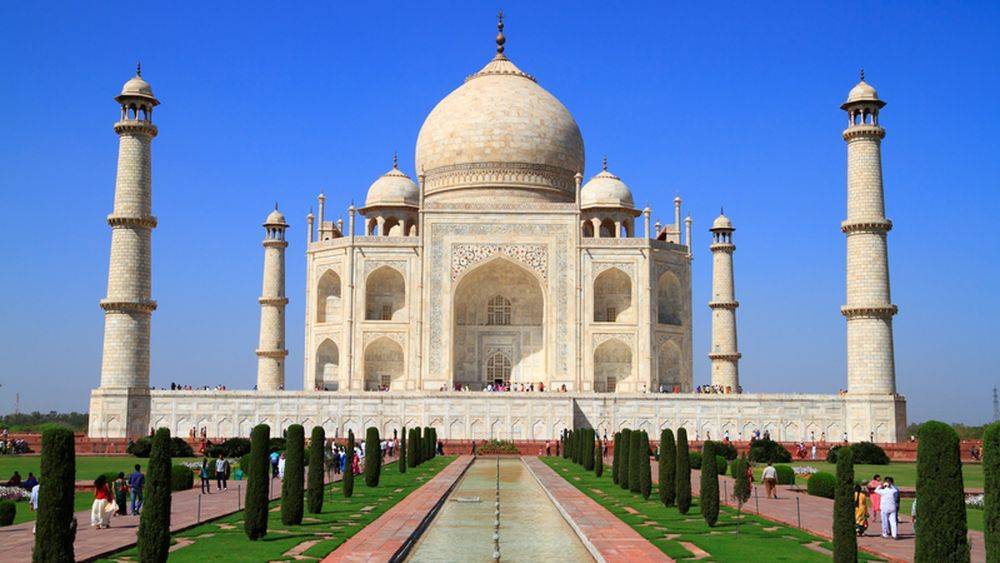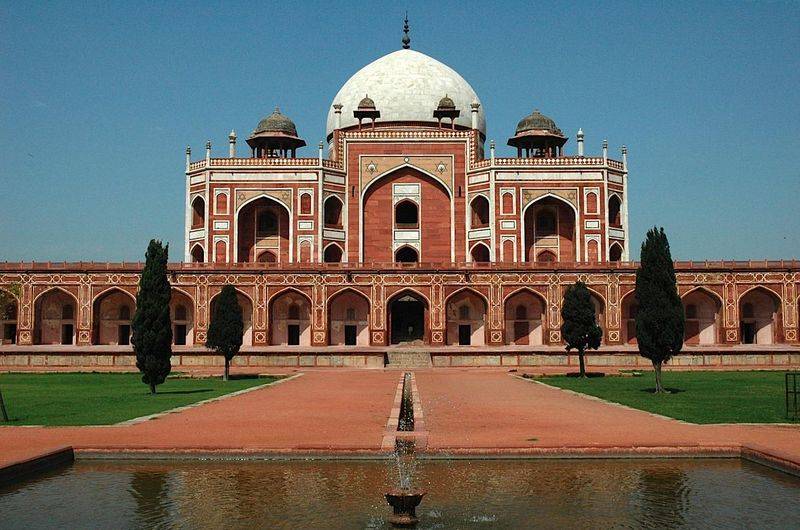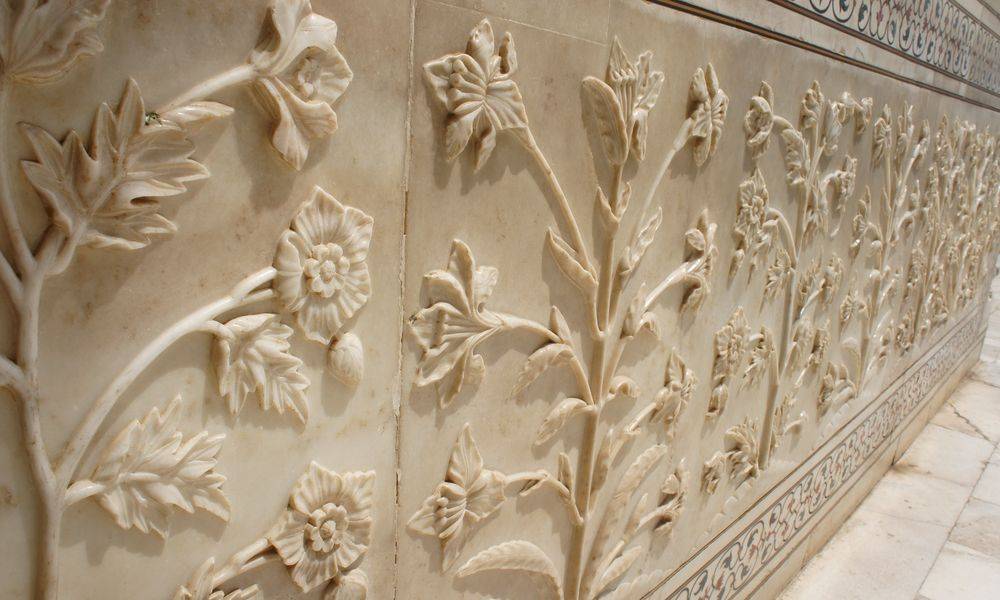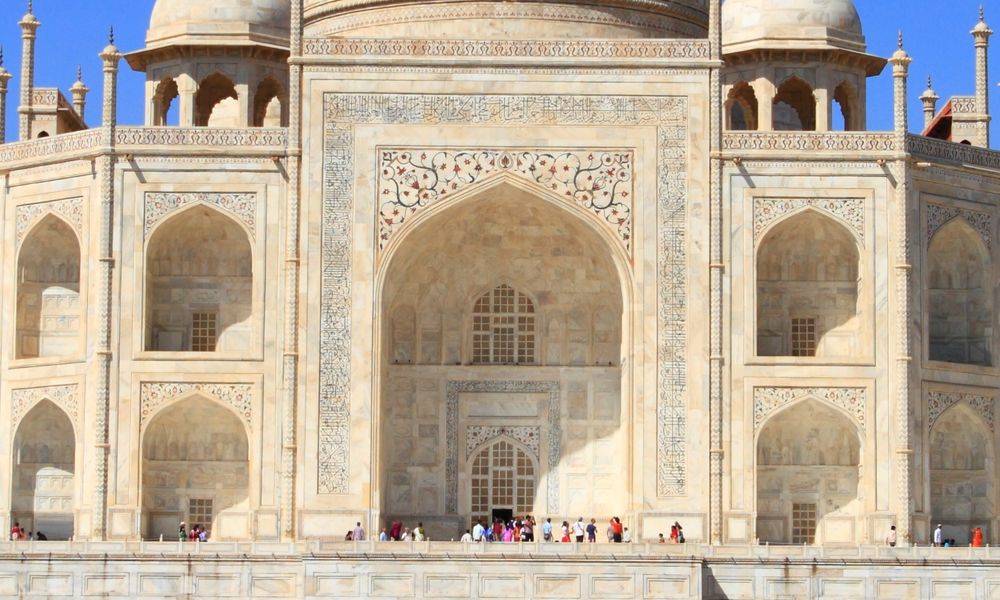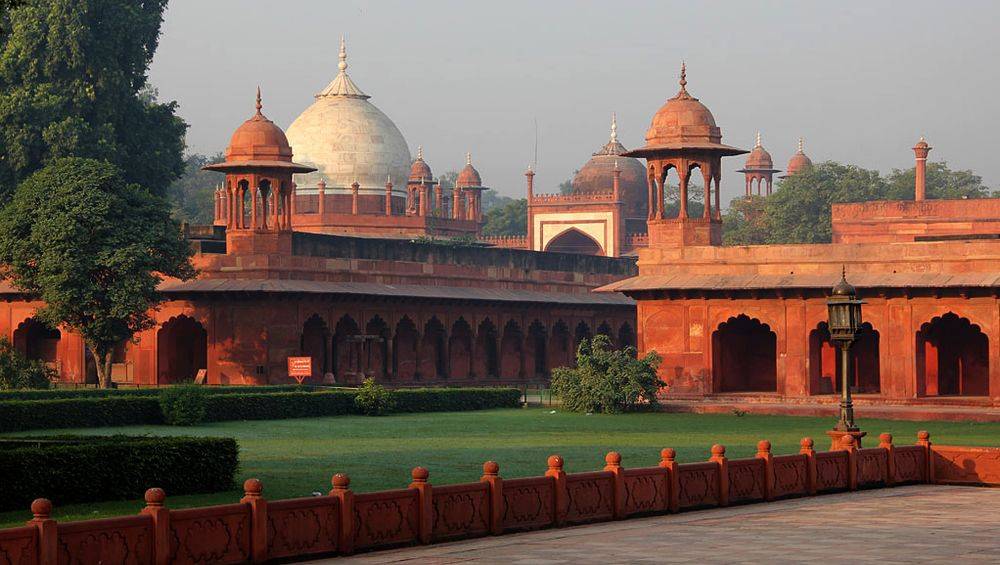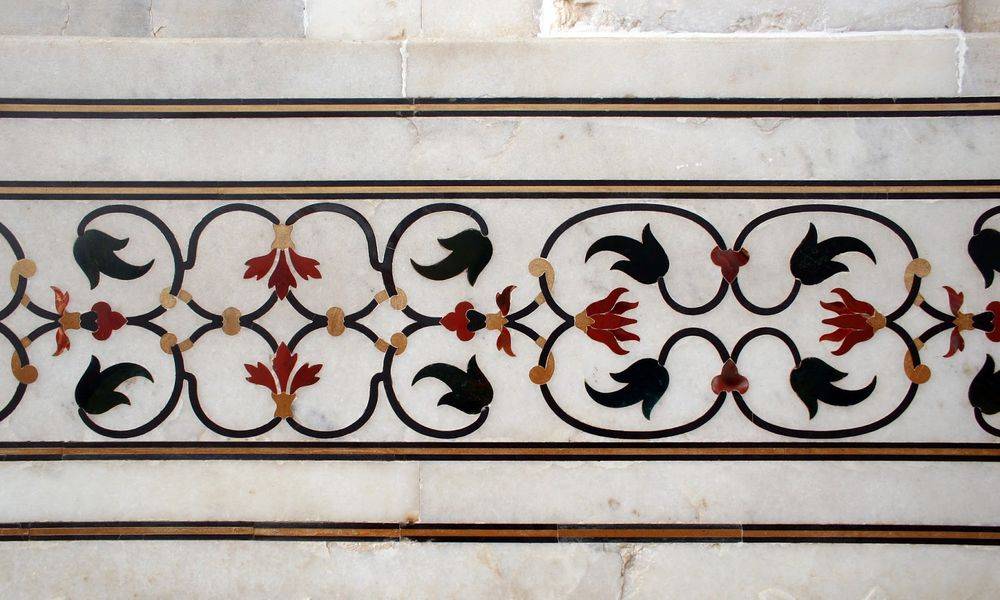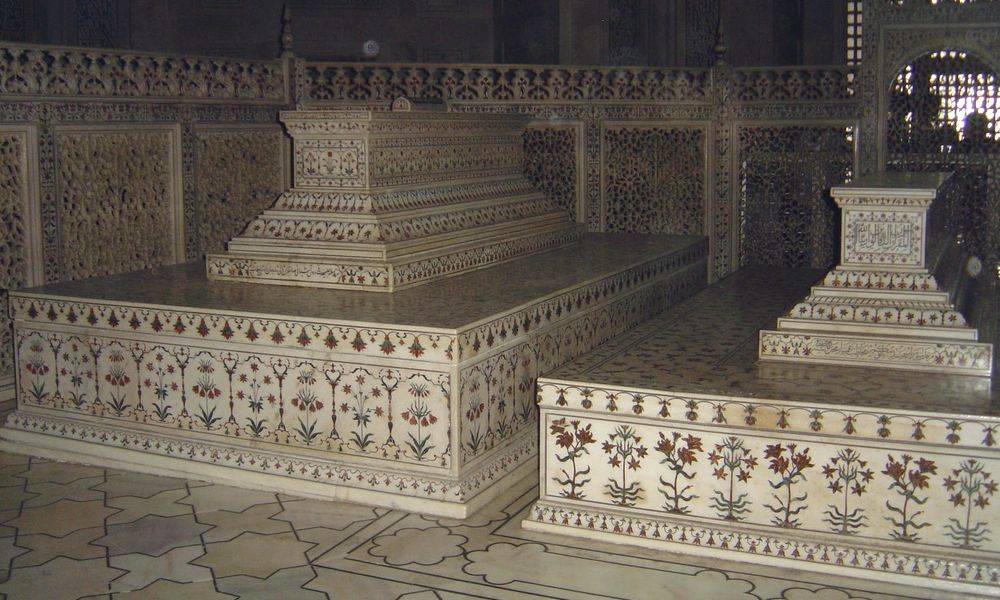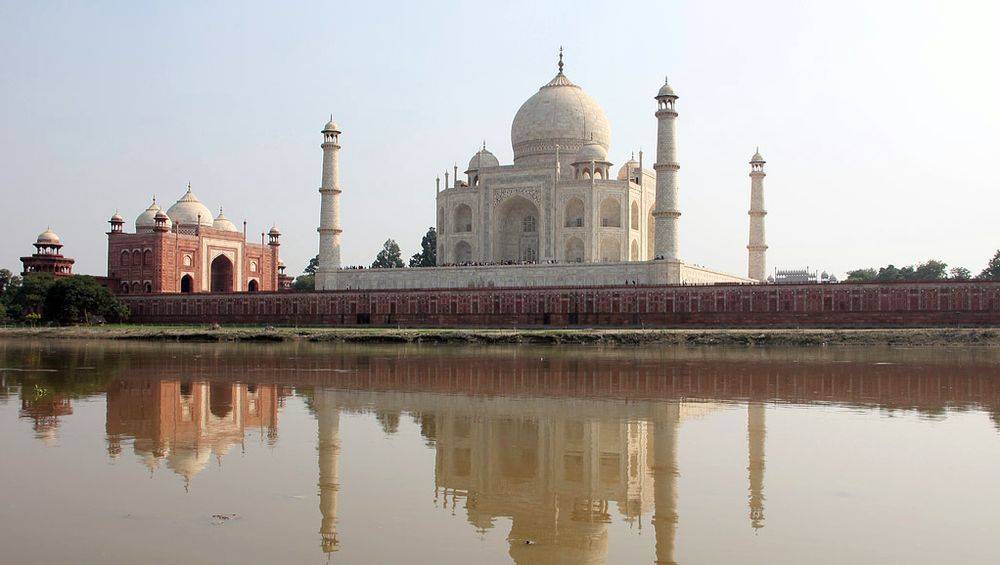The history of art is a school subject taught to varying degrees in the National Education. It is found mainly in high school, but it is also a subject of higher education and sometimes primary. Its role is to study artistic works from an objective as well as a critical point of view by placing them in their geographical, historical, social and environmental contexts. The symbolic aspect accounts for a large part of these studies. From a more practical point of view, the history of art highlights the artists, their lives, their opinions to highlight the way in which they are put forward through the works. It also explains the impact of a work on the public in a cultural, demographic or religious context.
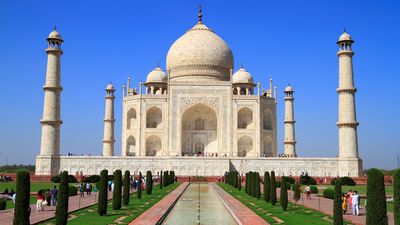
The mausoleum of the Taj Mahal
The taj Mahal is a work of art, as can paintings, sculptures or plays. Architectural work, it is regularly on the curriculum of most courses. The rest of this page provides explanations on its construction, its origins, its symbolism and the public's vision of it.
But before going further, we must distinguish the curriculum because the National Education does not expect the same knowledge from the students depending on levels. Click on your level.
What differentiates the levels in the history of art is not the number of works studied or their qualities but the depth with which learners need to highlight their knowledge. This means that the learning mechanism is the same, regardless of the level of the student. So in primary school you have to answer in the same way as for higher level courses, but of course by lightening the answers. Moreover, when we say "primary level", we should rather say "cycle 2", from CM1 to 6th. It is at this age that students are best able to do this kind of work when they are young.
What is expected of the history of art is an analysis of the forms, techniques, meanings and uses of the work studied. With regard to the Taj Mahal a primary school student can answer factually some questions, this is usually what is done in class, but if he has to produce himself a text on the monument, he will have to base himself on these 4 work items.
But first of all we must start with some simple information, to locate the monument.
The Taj Mahal is an Indian site located in the city of Agra, a city in the southwest of the capital New Delhi. It is the tomb of Mumtaz Mahal and her husband Emperor Shah Jahan, an emperor who ruled over a territory as large as India in the sixteenth century. When his wife Mumtaz died the emperor made him build the most beautiful mausoleum so that she could spend eternity in peace. When, much later, he died, his son buried him next to his wife. The Taj Mahal is a tomb, above all. It was built between 1631 and 1653 by Ustad Ahmad Lahauri. Nowadays it is registered in the world heritage of humanity. It is the most famous monument of India.
Then you have to do an analysis of the forms, which can be expressed as well.
It is a set of buildings and gardens surrounded by high walls cut into three parts. In the South, there is an inner courtyard and four small gardens leading to 4 buildings. There is an information desk and what it takes to visit the tourist site. Further north are the gardens which are perfectly regular, square shaped. There are 4 of them, separated by very long canals, joining at the center. The place where they meet has a fountain. Finally to the North are the three most important buildings of the Taj Mahal: The Mosque, in which the Muslims meet to pray, the guest house, which is only for symmetry (It is perfectly identical to the mosque) and in the middle the main building, the mausoleum.
The mausoleum is the most famous building in India, it is his that we think when we talk about the Taj Mahal. This is a white building decorated with flowers. It is octagonal, it has four large faces and four small ones. Large faces have a very wide porch and lead to the interior. Inside, there are several rooms including a main one that has two tombs. The building is surmounted by a bulbous dome and the mausoleum is accompanied by 4 minarets, so large round towers and fine.
This description naturally leads to the analysis of techniques.
The Taj Mahal was built between 1631 and 1653. The construction was led by Ustad Ahmad Lahauri. Most buildings are built of red sandstone, a stone that can be very hard and made of compressed sand. The mausoleum is entirely covered with marble slabs. The construction was done with rather simple techniques, without particularities. The most interesting are the sets, very numerous, that can be found everywhere. There are two kinds of decorations, those made in low relief and those made in pietra dura. Bas relief consists of engraving patterns (flowers, essentially) on the marble slabs while the pietra dura, it is a puzzle made of stones. The artists used gems or not with bright colors.
Then we must ask the question of the meaning of the Taj Mahal.
Aside from it, it would be a strange question to ask the meaning of the Taj Mahal. But here we can argue that the Taj Mahal represents a passage from earthly life to Paradise. The Taj Mahal is divided into three parts. The first, at the entrance, is a courtyard with ancient mausoleums. The courtyard represents an antechamber between everyday life, that is to say all that is outside the monument, and the life of the hereafter. Between the courtyard and the gardens, there is a large gate through which one must pass to arrive at the gardens, which are a representation of Paradise. At the time of the construction of the Taj Mahal, the sixteenth century, a garden was seen as something positive, rare. Only the richest could have one, it represented the best, and it became a symbol of Paradise. Finally the third part of the Taj Mahal is the most sacred part. There is the mausoleum, the mosque and the guest pavilion. The builders of the mausoleum wanted this part to be the holiest part of Paradise, the best of the best. The Taj Mahal therefore has a simple meaning, it is a passage from everyday life to spiritual life, that there is in the hereafter.
Finally comes the 4th part, that on the use
The use of a work of art is its interest, its raison d'être. For the Taj Mahal the use is simple, it is about a tomb, quite simply. The use of the work is therefore to offer a last burial the prettiest possible to a woman and, later, to her husband. Nowadays the use has greatly changed since the Taj Mahal has become a tourist site, we can say that the Taj Mahal is used to promote India and more particularly Indian art.
It only remains to give a personal opinion of the Taj Mahal. There, it is more difficult to propose since it depends on the way the student perceives it. Does he find it beautiful? Well proportioned ? Great? This is the most personal part, so it's a part that has to be done entirely by the student.
That's it, it was a few tracks to do a history of art history at the primary level, or more specifically at Cycle 2 because Cycle 1 is not really the right age to make art history it is rather an initiation that is offered to them.
Que doit contenir un devoir en histoire de l'art ?
The implementation of the teaching of the history of the arts is based on three elements of the teaching of the history of the arts:
- historical periods
- artistical domains
- Lists of themes
We must find the answers to its 3 elements in the history of art. Moreover the works are analyzed starting from at least four criteria: forms, techniques, meanings, uses. It is through these four criteria that we will study the Taj Mahal.
Shape analysis
This criterion consists of studying categories, types, genres, artistic styles, structure or composition. This is a rather important criterion for the Taj Mahal because its general shape and the shape of its components is very much associated with its geographical and historical environment, much more than is the case for the Eiffel Tower for example.
Analysis of techniques
This second criterion allows the study of materials, materials, tools, supports, instruments, but also methods and techniques corporal, gestural, instrumental. Regarding the Taj Mahal this part is not necessarily the one that takes the most space simply because there are large gaps in our knowledge of how the monument was built.
Meaning Analysis
Third criterion in the description of a work, it approaches the messages (transmitted, received, or interpreted), the senses (usual, general, particular, the variations of the senses in time and space), the code, the sign (meaning / signified), receiving, interpreting, decoding and decrypting. This is a criterion that will highlight the symbolism of the Taj Mahal, of course.
Usage analysis
This last criterion leads to study the function, the use, the categories of recipients and users, the destination, the use, the transformation, the rejections, or the diversions of the work. If this part is very important, it does not need a particularly long development with regard to the Taj Mahal, whose function is simple and the straight historical trajectory.
Finally, it is important to give your feelings on the work, what it evokes for itself. This part being purely subjective, it can not be developed here, and yet there is still a short text giving my own feeling on the monument.
Example of a duty on the Taj Mahal, in the history of art
But above all, we must begin with a short description of the work and its context that will serve as an introduction. In the case of the Taj Mahal one can not include information about the artist because the monument is said to have had several architects, although Ustad Ahmad Lahauri is the name associated with the builder of the building. On the other hand, it is much easier to talk about the one who initiated the construction, the Mughal Emperor Shah Jahan, as well as the reason why he had it built.
Introduction
The Taj Mahal is a complex of several gardens and buildings girded by a wall. It is located in the city of Agra, India, a city located less than 200kms from the capital New Delhi, in the South West. Agra is in the province of Uttar Pradesh. In the city the Taj Mahal is located a few kilometers east of the city center, in a suburb with anarchic and dense urbanism that touches the monument by the South. The local river, Yamuna, passes north of the complex.
The complex consists of a large rectangle oriented North-South, with the main entrance South side. It is divided into three parts. In the South, the inner courtyard, in the center, the gardens, in the North, the tomb and its annexes. The courtyard is lined with four gardens and four ancient mausoleums, two housing the tombs of the first two wives of Shah Jahan, two housing the ceremonial staff and equipment. Nowadays, this is where the tourist office of Taj Mahal is located. This courtyard is separated from the gardens by the Darwaza-i rauza, a gigantic door very well decorated. It is a symbolic passage, that of the terrestrial life (the court) to the spiritual life (the gardens). This is indeed a representation of Paradise, which is why they are so clean, so perfect, even though this is to be put in perspective since at the time of construction the gardens consisted of a lot of unstructured vegetation like fruit trees scattered a little all over. The great rigor of the lawns is due to the English who imported their English gardens to the Taj Mahal. But initially the gardens were still very regular. Finally to the north is the mausoleum, the mosque and the guest pavilion, which has no other purpose than to ensure symmetry on this large terrace.
The Taj Mahal was built to house the grave of Mumtaz Mahal, the third wife of the Mughal Emperor Shah Jahan, for whom he had, it seems, a great love. On his death the sovereign ordered the construction of the most beautiful mausoleum that can be done so that his wife can spend eternity, it is the origin of the construction of the Taj Mahal. But this reason is rather succinct, so here are more elements concerning the historical and religious context of the time.
How does it fit into the works of his time?
Shah Jahan was the 5th Mughal emperor, a dynasty created by Babur in the 15th century. Babur was a descendant of Tamerlane, who in the fifteenth century conquered a vast territory over western and eastern Asia, but whose empire collapsed only in the nineteenth century. It was he who took Kabul, then, later, Lahore, forming the beginnings of an empire that will reign over the whole of North India, then on a territory going from Persia to Burma, to the South of India. Of Muslim religion, the different emperors imported their way of life to the disparate populations whose territories they conquered, but the reverse was true too, most of the emperors introducing in their customs elements of the way of life of the natives. This is especially true for architecture, an art carried by many of the earliest emperors. If the first two emperors, Bâbur and Humâyûn, only conquered an ever wider territory, his four successors, Akbar, Jahangir, Shah Jahan and Aurangzeb, respectively, developed the architecture by melting more and more finely the characteristics of the Islamic art, the starting point of their cultures, Persian art, of which they were very geographically and geopolitically close, and the Hindu art, of which they directed the populations. It is this mixture of 3 influences that gave rise to more and more complex buildings, more and more beautiful, more and more proportionate, until arriving at this masterpiece that is the Taj Mahal.
There are a large number of Islamic-Perso-Hindu style buildings in India. They were built for the exclusive attention of the emperors, their close relatives, great servants of the country or personalities considered as Saints. The people, whatever their religion, could not claim such a tomb, even if the deceased was rich.
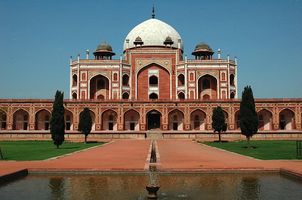
The tomb of Humayun
The first major building of this style was the Humâyûn tomb. Built in Delhi, near the shrine of a prominent Muslim saint, Nizamuddin Auliya, he is known as Purana Qila. It is a large dome-shaped structure on an octagon Baghdadi, which is an octagon with four alternating sides long and short sides. It is built of red sandstone and decorated with white marble trim. The next is Sikandra, the tomb of Jahângîr, which he had built similarly to the Taj Mahal but without the dome. This oversight was voluntary, it was to allow the soul of the deceased to go to heaven. This is the equivalent of the "Pentecost Holes" of Christian cathedrals. Other monuments of this style exist and can be visited nowadays, for example the tomb of Nur Jahan. He was Shah Jahan's finance minister and was close to Emperor Jahangir. It was this proximity that earned him his royal style tomb, covered with white marble, a noble material that only the royal family could have. We can also mention the tombs of Saints Moinuddin Chishti in Ajmer and that of Nizamuddin Auliya in Delhi, which were also made of white marble.
You have more information on the historical context of the construction of Taj Mahal on this page.
Shape analysis
Dissing over the shape of the Taj Mahal is a heresy because the Taj Mahal is a complex of several buildings, so we can not speak of forms in the literal sense but rather in the figurative sense, unless we speak only of the mausoleum. However, as it is the mausoleum that is the best known, it is possible to propose a mixture of both, with a first part on the general architectural style and the other on the mausoleum. But we must start by saying that the Taj Mahal is a work of art in the field of architecture, it goes without saying.
As we saw in the introduction, the Taj Mahal is a set of 3 parts. The first a courtyard, gardens and two mausoleums, they represent life on earth, the second is composed of gardens, representing life in the afterlife, and the third corresponds to the most sacred elements, the mausoleum, the mosque and the guest house, which is only the counterpart of the mosque, built solely for symmetry. The separation between the courtyard and the gardens is made by a wall against which is a sheltered passage and a monumental door, the Darwaza-i rauza. Finally the walls contain, on both sides of the gardens, various small buildings, including the West which hosts a small museum.
Islamic influence
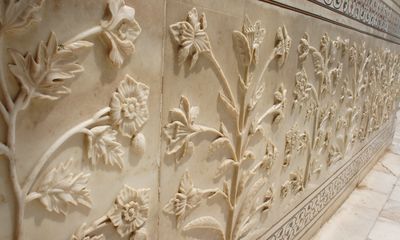
Flowers engraved in marble
All these buildings have an architectural style Islamo-perso-Hindu whose influences are emerging at the mere sight of one of these elements. Let's start with the Islamic style that we find above all in the calligraphy inscriptions on the walls of the gateway to the gardens and especially on the walls of the mausoleum. These inscriptions are engraved in black marble in white marble and correspond to Arabic writing. The text is a rework of verses from the Quran calling on the faithful to fear Allah and calling them to be pious. The analysis of signifiers, below, gives more information on this subject. The Muslim style is also in the decorations because they are essentially Islamic, it has almost no Hindu or Persian decoration on the Taj Mahal (with the notable exception of the presence of typically Far Eastern flowers like the lotus, but in this case it is rather an influence of the Asian culture on the decoration that the establishment of real Asian decorations on the monument). The decoration is based on flowers (for many), plants (a little less) and geometric patterns (quite a few). These three themes are the only ones of the decorations, there are no animals for example. It must be understood that Islam was born in arid regions of the world. The early Muslims had few plants around them, and those lucky enough to have a garden could legitimately feel better off than others. It had become the mark of the powerful, this ability to have a garden. The early Muslims considered plants as an important blessing and valued them in their lives. So naturally we find plants in decoration of an Islamic monument, and even more logical than flowers, a plant nutritionally useless and thus marking even more the power of the one who has, since this one can allow itself to have flowers, it is that it has a garden sufficiently important to have nutritious plants.
The plants are thus seen by the Muslims, at least at the time of the construction of the Taj Mahal, as a luxury, even more if it is flowers, that explains their presence in large numbers on the Taj Mahal. Geometric patterns are also a feature of Muslim art. The representation of the prophet being forbidden, the Muslim art naturally turned away from the realism of the faces to approach the abstract. In mosques the same geometric patterns are often repeated to infinity, it is a way of showing that Allah is present everywhere in the world, where Christians center the representation of God on a particular element of the churches, for example. example in the form of rosettes, or cross in the choir.
Apart from decoration, the influence of Islam is also present in the general architecture of the monument. For example, the mausoleum is surrounded by four minarets that can be found in all major mosques, from the Great Mosque of Mecca to the Blue Mosque in Istanbul. And then, the mere presence of a mosque to the right of the mausoleum is direct evidence of Muslim influence at the Taj Mahal.
Persian influence
Persian influence is found mainly in the general form of buildings. It is to her that we owe this octagon used as a plan of the mausoleum, a regular octagon with 4 sides smaller than the others. The interior of the mausoleum is made of a large central room, also octagonal, a room flanked by four other smaller rooms, all equally octagonal. It is a typical Persian style imported by the first Mughal emperors. The most emblematic element of Persian art is probably the bulb-shaped dome, a style found only in this region of the world and which was born on the side of present-day Iran, the cradle of Persian civilization.
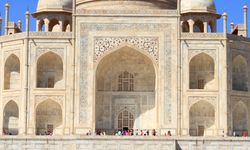
An iwan of the mausoleum
There are other buildings in the inner courtyard with a similar dome, they are also of Persian influence. Aside from the dome, the second really characteristic element of Persian civilization is the presence of iwans. An iwan is the name given to the wide, shallow porches that stretch ogival to the sky. There are many at Taj Mahal, the 8 main ones being on the 4 main faces of the mausoleum and on the 4 sides of the access gate to the gardens. But each of these faces also has 4 secondary iwans, and each small side of the octagon also contains two, which makes, for the mausoleum, 28 in total, and for the portal, 20 (because it is a square, it does not have small sides). An iwan is more than a passage, it is a symbolic passage to a sacred place, often a mosque. The ogive shape indicates a willingness of the passer-by to rise spiritually to Heaven. A similar comparison can be made with the flamboyant Gothic Gothic style, consisting of ogival interlacing which aims to mark the elevation of the Christian to heaven.
As we can see, the Persian influence is therefore quite present in the Taj Mahal. Moreover, a simple glance at buildings in Iran, Uzbekistan or Turkmenistan shows important similarities with the Taj Mahal, which is nowadays in a different artistic influence.
Hindu influence
The Hindu influence is more discreet compared to Persian. It must be said that at the time of its construction, in the seventeenth century, North India was under the leadership of the Mughals, an Islamic dynasty who conquered territories populated by different civilizations, including Hindu peoples. Hindu art thus introduced itself into Mughal art, but with less presence.
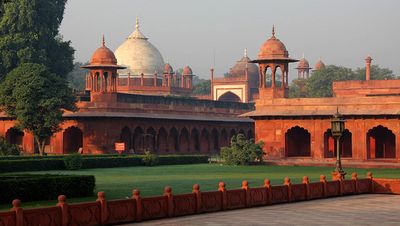
Hindu arcades and secondary domes
This influence is found in various architectural elements, such as the compound of the complex, which is a high crenellated wall. The crenellage is also on the roof of the building hosting the museum, west side of the gardens. Another important element is the auxiliary domes, located on the roofs. They are intended to highlight the main dome or on the contrary serve as main domes, but the style is typically Hindu. It is an inverted half-sphere held at height of man by columns, which is a kind of kiosk. The mausoleum has 4 on both sides of the main dome. These little domes are very present on the gateway to the gardens, there are 4 (one per corner), but also two rows, side by side, which forms a kind of galleries.
Another Hindu influence is in the arcades. The dividing wall between the inner courtyard and the gardens is lined with arcades whose style is frankly Hindu. From the seventeenth century to the early twentieth, these arches were used to shelter poor salespeople, because the inner courtyard housed infrastructure to help the poorest.
Others infuences
The Hindu, Persian and Islamic styles are the three great styles of the Taj Mahal, but there is a fourth one, less known but which today has a great influence on the general aspect of the complex: The English style. In fact, the English colonized India for about a century, and when they administered the Taj Mahal, the gardens were in the original state, ie, orderly, but made of many trees, shrubs, and various plants. The English imported their way of life and razed a large part of the garden to transform it into an English garden, that is to say with clear and perfectly maintained lawns, with very few plants. It is from this period that gardens date as we know them today, but before they were much more "clutter".
Note that the Indian state has never put the gardens in the original style, he preferred to keep the English gardens inherited from its history.
Thus ends the description of the Taj Mahal. To learn more, you can see the page on its description.
Analysis of techniques
The construction of the Taj Mahal has required great skill in many areas, but it is not easy to find among the historical documents elements on its construction, especially. Already you must know that the Taj Mahal was not built by a particular man. Only the sponsor is well known is Shah Jahan, the 5th Mughal emperor who lived in the seventeenth century. It was for his third wife, Mumtaz Mahal, that he built this splendid mausoleum, but he did not mandate a particular architect. on the contrary, we know that there were several who worked on the monument. On the other hand, one name stands out among the others, and it is often him that one quotes, forgetting the others: Ustad Ahmad Lahauri.
The workers are even more unknown of course. We know that there were 20,000 working on the site, and that there were many trades. Construction lasted from 1631 to 1653, but the last five years have been spent on landscaping, meaning that out of the 22 years, only 17 have been used for building construction. It seems that very little if we consider that the workers did not have at their disposal the same tools that we have now.
When one simply looks at the gateway to the gardens and the mausoleum, one notices that they are not made of the same material. One is in red sandstone, the other in marble. And yet this is only an impression because all the buildings of the Taj Mahal complex are red sandstone. Sandstone is a stone made of agglomerated sand. It can be friable, but depending on the pressure it has suffered over time it may be, as is the case here, an extremely hard stone. The red color is natural, a lot of buildings in North India have this color. The decorations on the walls are made, most often, of white marble, a color considered pure and therefore naturally associated with the emperors. Regarding the mausoleum, the most sacred place of the complex, it was decided to cover it entirely with white marble, from the ground to the top of the dome, and it is this cover that gives it its color. The mausoleum of the Taj Mahal is therefore not marble, it is only covered. Besides, it's clear when you look closely at the walls, we see that they are made of a multitude of square plates. The jointing of these plates is precise, the work is of a high quality.
If the assembly of the walls and roofs of the different buildings did not use particular techniques, the installation of the dome was more complex. It is also one of the know-how of Mughal craftsmen to be able to create such a bulbous dome (bulbous), well proportioned and also covered with marble slabs. It seems, without being sure, that the dome was built on a pattern made of indeterminate material, directly on site since at the time the workers did not have lifting equipment. As expected, it is hollow and has a double ceiling, inside. The main ceiling is the one seen from the inside, but there is a second one that marries, much higher, the shape of the dome itself. Note that the interior of the dome is bell-shaped, ie it does not follow the outer contours of the bulb, and that to ensure greater strength. Otherwise, the dome could have crashed on itself.
Another important element using a particular technique is the four minarets surrounding the mausoleum. If we look at them carefully we will see that they are slightly bent outwards. This is not a construction anomaly but a technique that the architects wanted for the unlikely case of an earthquake that would put down the minarets. Thus bent, they will fall far from the mausoleum instead of collapsing on it.
The case of decorations
More than the construction techniques themselves, it is undoubtedly the manufacture of decorations that required the most technical workmen. There are three types of decorations on the Taj Mahal: Paintings, bas-relief sculptures and inlaid pietra dura.
The paintings are rare, they are found rather in the mosque or the pavilion of the guests. They are very worked, but quite simple and there is finally little to say to their subjects.
The sculptures are more interesting. They are made in low relief, that is to say that the relief comes out of the support. If they stood out a lot (until they seemed to come out of the support), we would talk about high relief, but this is not the case here. The bas-reliefs represent exclusively plants or flowers and they are carved in white marble. These plates are placed outside the mausoleum, also inside, and on the lower part of the walls. There is an impressive amount. The technique of creating these bas-reliefs is the same as that used in Europe, namely the use of a block of marble that the craftsman will patiently hammer until enough material is removed from the sides of the block. Then, the more he advances in his work, the more the material withdrawn is accurate until it has only the desired decor. Then the plate is polished. Polishing marble is not very complex to do, it takes a little time, that's all.
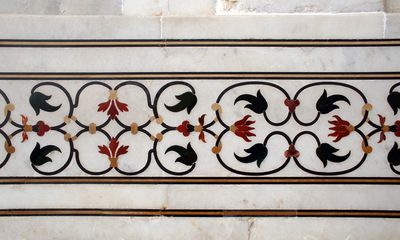
Pietra dura of Taj Mahal
Note an exception in marble sculpture: The balustrade of the central hall, in the mausoleum, which is entirely of marble. The decorations are plants that have been engraved from large plates extruded little by little until they form a stone lace. once completed the ensemble was polished to form the masterpiece that can be seen nowadays.
Finally, the most interesting decorations are the incrustations in pietra dura. The pietra dura is a technique invented by the Florentines in the sixteenth century and the Italian city had made a specialty. It is about lapidary marquetry, that is to say it consists of inlaying in a stone plate pieces made also of stone, but of different colors, to represent a decoration. The work requires very high precision, of course. There is a lot of pitra dura at the Taj Mahal, especially in the mausoleum, but not only. They were made by Italian artisans who came to work on site.
The technique is quite simple, whatever it takes time. It consists of making a drawing of what you want to achieve, then to cut the colored stones to the shape of the pieces. The depths of all the pieces must be uniform, which is quite complex to do. once all the parts made, it is then necessary to extrude the support plate according to the shapes of each piece, which must fit perfectly. Finally when everything is in place, the craftsman will polish the finished plate to make it smooth and shiny. This work, long, was repeated a very large number of times on the Taj Mahal.
You have more information about Taj Mahal's decorations on this page.
Meaning Analysis
The analysis of meanings is, with the analysis of uses, the least developed part of this file because there is little enough to say. The Taj Mahal is a mausoleum, so it's a grave. The symbolic features of a 17th-century Mughal emperor's tomb are found there - even though it was built solely for his third wife - that is, it contains essentially elements explaining the passage between earthly life and life in the afterlife. This passage is essentially symbolized in the structure of the Taj Mahal: The first part, corresponding to the entrance, is a kind of antechamber between the real world, that of the outside, and the divine world, symbolized by the gardens. The Darwaza-i rauza is the communication gate, it is this large square building facing the mausoleum. The inner courtyard, which is called "jilaukhana", contains the tombs of Shah Jahan's first two wives. The fact that he placed them there indicates a willingness on his part to differentiate his first 3 wives: The first two, with whom he had cold contacts, are not in Paradise but in this antechamber, between two worlds.
Paradise symbolized by the garden
Once the Darwaza-i rauza is past, Paradise opens, symbolized by the gardens. As we have seen above, a garden, for Muslims, is seen as a source of wealth since it brings the necessary food to man. Being considered beneficent, it was naturally associated with the positive, then, by exaggeration, with the divine. But the strongest symbol regarding gardens is their exact symmetries. Order, rigor, precision are associated with divine qualities and that is why the Mughal gardens are so ordered. As the supreme tomb, the Taj Mahal must be as orderly as possible, of course. The presence of fruit trees is a symbol of abundance, but it is the flower that is most important because having flowers in a garden is a luxury, since they take part of the cultivable land for purposes other than nutritious.
The gardens are cut by 4 channels that join the center in a fountain, the Al Hawd al-Kawthar. The 4 channels are representations of the 4 rivers of Paradise of which the Koran speaks. Here there are 4 canals, 4 lawn areas divided into 4 sub-areas, the mausoleum with 4 minarets, 4 secondary domes, and so on. The number 4 is therefore very present at Taj Mahal. Al Hawd al-Kawthar literally means "Cistern of Abundance". She is here to quench the thirst of those who arrive in Paradise.
The elements rising to the sky
There are several architectural elements in the Taj Mahal symbolizing the ascent to Heaven. The most obvious perhaps is the bulbous dome of the mausoleum, which is an arrow pointing to the sky. Note that the top of the dome is composed of a lotus flower, symbol of purity. Otherwise the iwans have exactly the same function: Their warhead shapes indicate the rise to Heaven of those who cross them.
The verses of the Koran
The inlays that we see on the 4 main faces of the mausoleum and those of the gate of the gardens are verses of the Koran. If the verses embedded in the door call the believer to abide by the rules of Islam, those on the mausoleum are much more directive and clearly threaten anyone who does not abide by these rules and threatens them to be excluded from Paradise.
Symbol of the Taj Mahal nowadays
Nowadays the meaning of the Taj Mahal has evolved since it is a symbol of love. The Taj Mahal represents the perfect love, fusional, the one that a couple is at the top of their relationships. This symbol comes from the fact that this mausoleum was built by Emperor Shah Jahan for his wife Mumtaz Mahal, and that the latter was entitled to a grave at the height of the love he had for him. When we see the result, we can easily imagine the strength of this love, and in turn, the Taj Mahal has become synonimous with great love.
Usage analysis
What good can the Taj Mahal serve? The answer to this question is simple and finds several answers. It all depends on the time we take. The purpose of the Taj Mahal, the one that caused its construction, was funerary. It's simply a grave. Admittedly, a beautiful tomb, an empress's tomb, but a simple tomb. It was built only to house the body of Mumtaz Mahal, the third wife of the Mughal emperor Shah Jahan. The time of construction the body remained on the place of death, buried provisionally. The destination of the Taj Mahal changed once upon the death of Shah Jahan. The son of the latter chooses this tomb to bury his father alongside his favorite wife, while it was not designed for that initially. The proof is the arrangement of the cenotaphs in the main room of the mausoleum, which corresponds exactly to the position of the actual tombs, just below, in the crypt: The cenotaph of Mumtaz Mahal is in the center of the room while that of Shah Jahan has been added to his side, so he is slightly to the side.
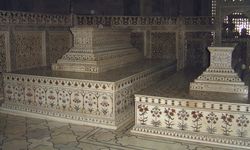
Cenotaphs
The sanctity of the site was not disturbed for years until the British colonization of India in the mid-nineteenth century. During all this time the monument remained an inaccessible tomb, only some authorized persons being able to work there. When the English began to administer the Indies the Taj Mahal became a showcase of "Indian" art (which was false, as said above). The lawns were reworked to fit the English people's idea of a garden (hence the impeccable lawns that still exist today) and the entire site was willingly more open, losing its sacred side. Visibly, it seems that the mosque was continuously active during the English domination. The Taj Mahal had become a symbol of the English presence in the colonies, as it was said at the time.
Since the decolonization of India and the creation of the republic, the Taj Mahal has been re-appropriated by the Indians, but they have rightly turned it into a tourist site, the history having bequeathed this tomb which loses over time its sacredness. The use of the Taj Mahal is therefore touristy now.
The recipients
If we ask ourselves the question of the recipients and the users of the Taj Mahal we come back to the same cases as those seen above: From a personal point of view, the Taj Mahal is used by a Mughal couple, but the main target audience is the mass of visitors from India who come to Agra on purpose to see the monument, knowing that if it had not been there they probably would not have come, Agra not being a specially tourist destination. Note that the Taj Mahal is considered by all civilizations as a wonder of the world, ie it is not addressed to a particular people. This monument is known as Asian as well as Western, civilizations of the Middle East than peoples of South America, etc. It is in all cases a symbol of love, for all.
Personal feelings
Difficult to give guidelines for the study of this monument when it comes to give his personal feeling about this monument, simply because if it is personal, the feeling can not be reproduced as such for others . Nevertheless, let me write here the impressions which emerge from the study of the monument.
The Taj Mahal is sumptuous, this word seems to be the right one because it gives at the same time a physical description and an impression of strength which suits him well. In this word there is greatness, beauty and power, and this is what emerges from the study of this monument. The whole world knows the mausoleum, but few are interested in the interior decorations, the pietra dura which is a technique of incrustation complex and that one finds nevertheless absolutely everywhere on the mausoleum, and even on other elements of the complex . It is probably this decoration that is most surprising for its quality of execution and the time of work that it took. Even the bas-reliefs seem dull, with little interest whereas taken alone, each of them can be seen as a true masterpiece of engraving.
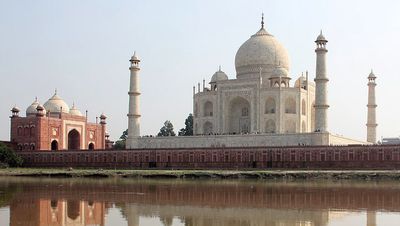
The Taj Mahal seen from the North side
The strength of the mausoleum is also expressed by its location. The Mughal-style buildings are almost all arranged in the same way, perfectly centered on the gardens. Here it is not the case, the most sacred part being north of the complex. This innovative layout is a complete success in that it allows visitors to have a beautiful perspective that magnifies the monument, where other monuments of this type seem closer, have less perspective.
The site is also a haven of peace. Placed on the edge of town, in an area with a very dense habitat, it seems to offer visitors an impressive calm that reinforces the feeling of being in a sacred place. Those who came back, and I have the chance to have rubbed shoulders, confirmed this feeling to me, and that despite the crowd of tourists thronging in the gardens or inside the mausoleum.
Calm and strength are for me the two main characteristics of the Taj Mahal. Its beauty seems unrivaled in the world, it simply puts it among the most beautiful architectural works in the world. Despite the time spent on this monument I have not found any negative points to put forward. This is doubtful lack of critical sense, but it can also be the monument that impresses, only the one who is interested.
See also:






